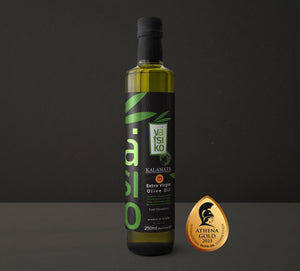Greek Olive Oil
Greece is a country located at the tip of the Balkan peninsula, at the crossroads of the European Union. Nine geographic regions comprise Greece: Macedonia, Central Greece, the Peloponnese, Thessaly, Epirus, the Aegean islands (including the Dodecanese and Cyclades), Thrace, Crete, and the Ionian Islands. Stamatopoulos & Sons certified extra virgin olive oil comes from the Peloponnese, specifically the southwestern area in Messinia. Our family estates are located in the villages of Christianoupoli and Mouzaki. The microclimate is ideal for Koroneiki olive production, which eventually turns into olive oil. Read more about the koroneiki olive here.

FROM THE USITC (United States International Trade Commission) 2013 STUDY:
“Greece plays an important role in global olive oil production, but little of its oil enters world markets as a Greek product. Rather, most Greek olive oil is consumed domestically (mostly through direct sales to consumers), as Greece has the highest per capita olive oil consumption in the world. Most of the remainder is exported to major bottlers in Italy for blending with extra virgin olive oils from various sources. Greek extra virgin oil is known among blenders and bottlers as a component that raises the overall quality and flavor profile of a blend. Recent industry and government initiatives seek to reduce the sector’s dependence on bulk exports to Italy and to increase competitiveness by focusing more on selling differentiated Greek product.
Greek Olive Oil Production Overview
“Greece is the world’s third-largest olive oil producer, after Spain and Italy. Until recently, Greek production levels were subject to the alternate bearing cycle of the olive tree, but the variation between crop years is now lower, likely due to the increased use of irrigation and pruning techniques that reduce the effects of this cycle.

"Greece relies more heavily on a single olive variety than Spain or Italy, with the Koroneiki olive accounting for about 80 percent of production. The Koroneiki variety produces high-quality oil for which there is strong demand. Other common varieties are Manaki and Athinolia, grown primarily in the Peloponnese.
"The average farm size in Greece is only 1.6 ha, just slightly larger than in Italy. About 70 percent of Greece’s olive-growing land is considered “disadvantaged” by the EU, meaning that it is either steeply sloped or has other geographic features that make it difficult to farm. Often olive trees are the only crop that can be grown on the land. Because many farms are small and located on difficult terrain, most olives are hand harvested, and fewer Greek farmers employ modern production methods than either Spain or Italy. The sector’s low efficiency is reflected in the fact that Greece accounts for 22 percent of EU oil olive acreage, but just 14 percent of its olive oil production.
Factors Affecting Competitiveness
High Cost of Production
"Greece has high costs of olive oil production, largely owing to its reliance on traditional, small-scale growing and milling methods. Several factors contribute to the high cost of producing olives. Greece has a prevalence of old groves with declining tree productivity and yields, resulting in high per-unit costs of production. Low yields are also attributed to a lack of irrigation in most of the country’s olive groves. Further, wage rates are high and rising even as rates of labor productivity remain low. Labor costs were identified by a Greek bank as a major limitation on Greece’s competitiveness in the olive oil industry. Also, only about half of olive growers are considered professional farmers, and many operators rely on activities besides olive growing to supplement their income. Some only produce for personal consumption. Costs are also high in the milling sector, which, as noted earlier, is dominated by smaller mills using older technology, unable to benefit from economies of scale.
High Quality
 "Although production costs are high, Greece also enjoys a reputation for producing high-quality olive oil. In a good year, as much as 80 percent of Greek olive oil meets the standard for extra virgin grade, the highest share in the Mediterranean. Even within the extra virgin category, Greek oils can be differentiated from others because they have desirable flavor profiles and score well on chemical tests measuring quality. This is partially because oil milled from Koroneiki olives tends to be the highest in polyphenol content and low in FFA among all olive oils. Greek oils are also considered among the fruitiest and most robust. As a result, they are in high demand by bottlers for blending with other extra virgin oils to raise the overall quality and increase the flavor of the final product. As California growers who have planted Koroneiki explain, “Blending Koroneiki into our other EVOOs [extra virgin olive oils] ‘kicks up’ an oil’s flavor and fruitiness, giving the oil a better and more complex taste.
"Although production costs are high, Greece also enjoys a reputation for producing high-quality olive oil. In a good year, as much as 80 percent of Greek olive oil meets the standard for extra virgin grade, the highest share in the Mediterranean. Even within the extra virgin category, Greek oils can be differentiated from others because they have desirable flavor profiles and score well on chemical tests measuring quality. This is partially because oil milled from Koroneiki olives tends to be the highest in polyphenol content and low in FFA among all olive oils. Greek oils are also considered among the fruitiest and most robust. As a result, they are in high demand by bottlers for blending with other extra virgin oils to raise the overall quality and increase the flavor of the final product. As California growers who have planted Koroneiki explain, “Blending Koroneiki into our other EVOOs [extra virgin olive oils] ‘kicks up’ an oil’s flavor and fruitiness, giving the oil a better and more complex taste.
Lack of Marketing and Reliance on Bulk Exports to Italy
"Despite producing mostly high-quality extra virgin oil, most Greek oil is exported in bulk for blending, rather than as single-source branded products. The Greek association of olive oil manufacturers attributes reliance on bulk sales to a lack of consumer awareness of the quality of Greek oil in overseas markets, owing to insufficient focus on consumer education and marketing on the part of Greek producers. As a result, at least 80 percent of exports are in bulk in a typical year. Most bulk exports are to Italy and used in blends by bottlers, and as much as 20 percent of the content of oil blended and bottled in Italy may be of Greek origin. This sales channel dates back many years and is firmly entrenched. Because producers have few alternative marketing outlets, Italian buyers often procure Greek oil at prices below market value with cash. Longer-term contracts are rare, a source of frustration for one U.S. blender who had experience purchasing Greek oil. While farmer cooperatives in Greece have attempted to increase the market power of the farmers, they generally “perform poorly, leaving room for private buyers to pay lower prices to producers.” An analysis of the strengths and weaknesses of the sector in Greece concluded, “A progressive reduction in the dependence of Greek olive oil on bulk exports to Italy is the key to significant improvement in its international success and the basis for a differentiation strategy that will increase the export price that can be garnered for the product.” Though Greece has made some progress in reducing the share of its exports flowing through the established Italian channel, product differentiation remains a major challenge for the Greek industry.”


